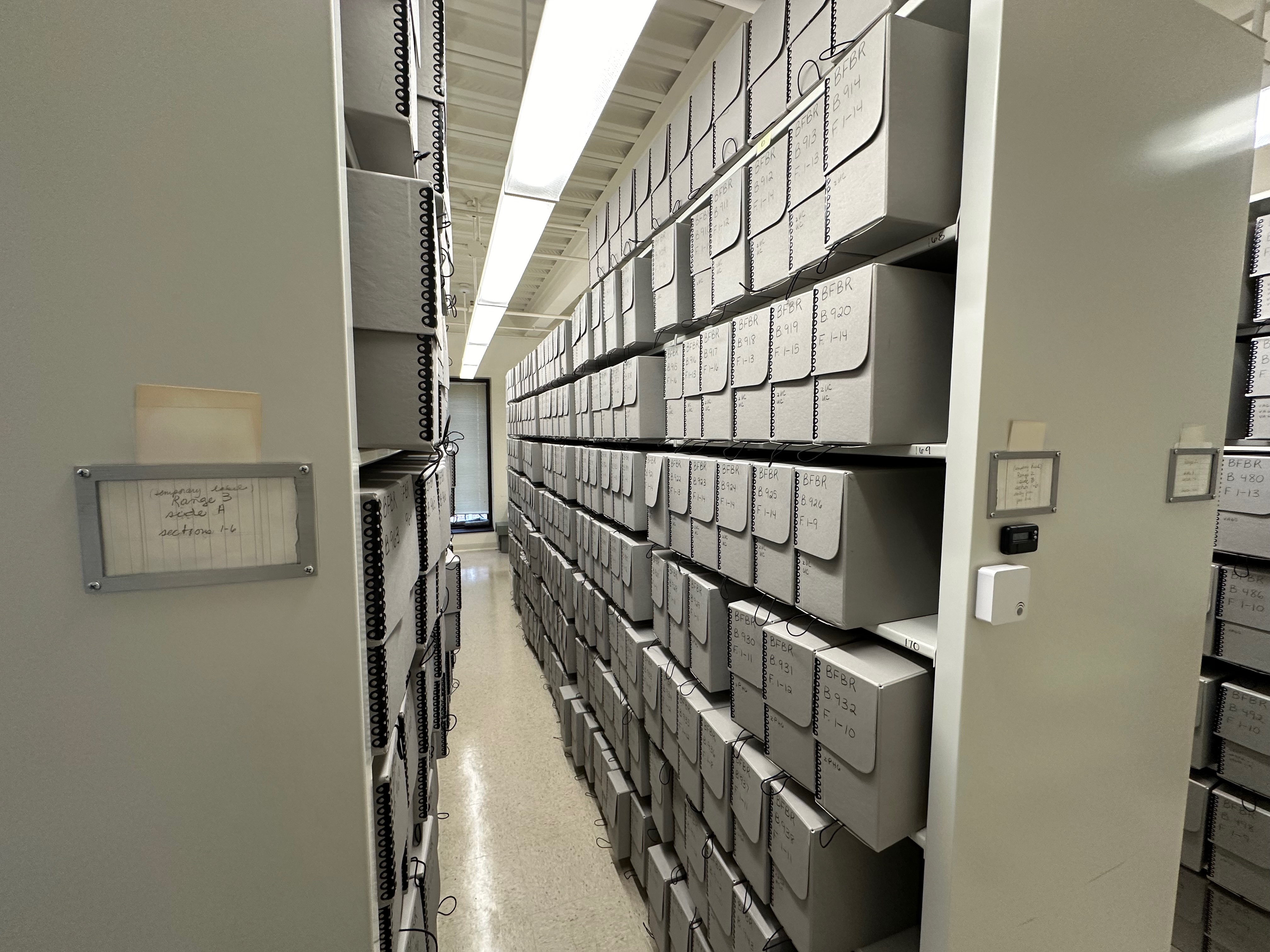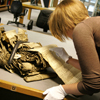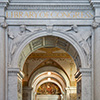At the John Carter Brown Library (JCB), it can sometimes seem like the entire collection is shouting. Some of this noise, particularly the dominance of European male voices, is unsurprising. John Carter Brown (1797–1874) was one of the first collectors of “Americana,” amassing a library of printed materials about the Americas from the late 15th century to the early 19th century. The collection’s silences are also unsurprising; among them, it can be challenging to find women authors or creators, or even subjects, in our collections.

Some archives and collections have an outsize presence as sources for the historical record. Others, like this one that doesn’t yet have an online finding aid, are harder to hear. Karin Wulf.
“Archival silence” has become a shorthand for absences in archival records. It also refers to biases in collections, collecting habits, and institutions that occlude people and their histories, and the power dynamics that are as present in the materials and the institutions as they are in the economic, social, political, and other relationships and structures they document. Archives can and do, as Michel-Rolph Trouillot put it, silence the past.
A keyword search for “woman” or “women” in the JCB catalog, for example, will return only hundreds of items, with a 1799 Philadelphia imprint of William Godwin’s Memoirs of Mary Wollstonecraft Godwin, author of “A vindication of the rights of woman” leading them, and a 1792 Boston imprint of Wollstonecraft’s Vindication itself coming in only at number 5. A simple search for “Sor Juana” will turn up dozens of volumes, some by but mostly about Sor Juana Inés de la Cruz (1651–95), the Mexican writer, poet, and nun, but also referencing other nuns. Neither Wollstonecraft nor Sor Juana is included in the little-used subject category “women authors.” Even these two extraordinary women are quieted, not because we haven’t collected examples of their work but because of the way that work was cataloged and the way the search sorts it.
Archives are full of materials and collections that have clamored for our attention. Naming the shouting is an explicit acknowledgment that some archives or sections of archives have long garnered outsize focus, and it attunes us to how their volume has shaped our histories. As more archivists, librarians, and scholars are offering analyses of archives as active interpretive agents, it also suggests an approach to the role of institutions in the silence and shouting alike.
John Adams was always a shouter, but his archives have been given a sound system.
What is a shouty archive? Historical materials that shout at us dominate collections in different ways. They can be extensive, literally taking up a lot of space. The scale of a collection can drive its use, and also the attention and prominence it receives from the institution. For institutions with a specific purpose and focus, some of these large-scale collections have a transparent logic. Presidential libraries in the United States may be the most straightforward example. The US National Archives oversees a system of presidential libraries that hold millions of items created by presidents and their staff in the course of their official work—and often much more, including materials generated before and after their time in office. But these archives are centered on an individual, a man (all men, thus far). The LBJ Presidential Library, for example, holds “more than 45 million pages of historical documents,” as well as extensive photos, audio, and more relating to Lyndon Baines Johnson. There is no mistaking who is at the center of a presidential library.
In institutions with a more diffuse collecting remit and large collections, the shouting reflects priorities and assumptions. Institutions have collecting priorities, and cataloging, curatorial, preservation, and other practices for describing, interpreting, and making materials accessible that then amplify some materials over others. Leaders of the many library and archival institutions founded in the 19th-century United States, for example, prioritized their own backgrounds and culturally dominant ideas about historical significance. That so many archival collections amplify the collected and preserved materials of white men, often engaged in politics and economics—and sometimes religion—reflects a pervasive bias about who and what had and has historical merit.
For the oldest historical society in the United States, the papers of president John Adams and his family are described as “the most important manuscript collection owned by the Massachusetts Historical Society [MHS].” The society has invested in an expert documentary edition (also funded by grants), a separate online search capability and digital access for Adams materials. Though the Adams Papers and related materials comprise over 100,000 items, which is an extraordinary collection by any measure, the MHS holds millions of items documenting mostly Massachusetts but much more across centuries, including more than 3,500 collections of manuscripts, diaries, photographs, and more. John Adams was always a shouter, but his archives have been given a mic and a sophisticated sound system.
Archival institutions, funders, and scholars inside and outside of archives have been launching a host of methods and projects to handle the different challenges of archival noise. One is to help certain collections shout more loudly—to find ways to amplify materials from within institutions. The Prize Papers Project, for example, explores the hundreds of thousands of items intercepted by the British admiralty in the course of taking “prizes” (i.e., ships in a legal capture between 1652 and 1815). Held at the UK’s National Archives, most of these multilingual materials had remained unexamined, with over 160,000 mostly unopened letters as well as books, accounts, and some personal objects.
Another structural response to the overwhelming representation of elites within traditional archival sources is to help us hear better with digital projects that provide either new aggregations or new search capabilities. If marginalized people have been marginalized in the archives, aggregating the available evidence helps makes the loudest materials speak more fully to their lives and experiences. Researchers can use Founders Online, the aggregator of early presidential and other documentary editions sponsored by the US National Archives, to research questions that were at the margins of these men’s interests—or, as in the case of slavery, at the very center of their interests while the individual people they enslaved remained marginal in the documentary record. In this context, the expert work of documentary editors has put the Adams Papers investment at the MHS, for example, to newly expansive uses.
Archives have facilitated some histories while impeding others.
Enslaved: Peoples of the Historical Slave Trade takes the same approach of aggregating multiple types of records from a wide range of locations, but with the particular goal of reconstructing “the lives of individuals who were enslaved, owned slaves, or participated in the historical trade.” Similarly, Keywords for Black Louisiana is building “a digital documentary edition of transcribed and translated documents that tell the story of enslaved and free Black communities.” Moving outside of traditional collections creates new aggregations based on multi-institutional source materials and new forms of amplification.
A powerful aggregating movement that has taken advantage of one of the noisiest features of traditional archival collections, colonial, state, and private institutions alike, is genealogy. The profusion of genealogy in archival records and as a priority of institutions has never been a secret, though only more recently the object of historians’ concerted attention. From the Mormon church–sponsored projects such as FamilySearch to transcription projects geared toward genealogists at archival institutions large and small, local and national, to the 10 Million Names Project helmed by historian Kendra Field at the venerable New England Historic and Genealogical Society, genealogical research takes full advantage of some of the highest volume of archival materials.
What all these approaches to shouting have in common is a basic recognition that context is key. The context for the materials that sit in a collecting institution was shaped by the perceived needs and interests of their creators as well as those who acquired, cataloged, curated, and preserved them. All these contexts come to bear on how we understand the materials from which we work. For institutions, recovering the context can require a fresh commitment to institutional transparency. It might mean a change in collecting priorities; my colleagues at the Brown University Library, for example, have made carceral collections one of their collecting areas. Or it might mean a slow coming to terms with the nature of the institution itself. At the JCB, understanding that we document the history of colonialism means a responsibility to that history. As a library of colonialism, we hold materials of extraordinary cultural and political and physical violence; we also hold materials that attest to humanity’s more noble ambitions. The noise within the walls, in other words, matters a great deal. How we hear it and what we make of it is as important as how we adduce the silences.
Like any metaphor, archival silence and shouting can only take us so far. For one thing, leaning on hearing as a historical practice or noise as an archival privilege evokes ableist assumptions. The larger point, though, that archives—aggregated material remnants of the past, and the institutions that hold them—have facilitated some histories while impeding others remains an important one. Cataloging is only one example of distributing our institutional resources. But as my colleagues and I have worked to expand our cataloging and metadata creation capacity, we are hyperaware of how important that information infrastructure is to how we know about our collection and how others come to know it. That neither Sor Juana Inés de la Cruz nor Mary Wollstonecraft was cataloged, long ago when their works were acquired, among “women authors” tells us something about what was valued at the time. Yes, there is a dearth of women authors and creators at our library. And yes, it can take several efforts to locate even the most celebrated among them. But some of Sor Juana’s compelling work sits on our shelves nonetheless, waiting.
Karin Wulf is the Beatrice and Julio Mario Santo Domingo Director and Librarian of the John Carter Brown Library and a professor of history at Brown University.
Tags: Features Research Archives

This work is licensed under a Creative Commons Attribution-NonCommercial-NoDerivatives 4.0 International License. Attribution must provide author name, article title, Perspectives on History, date of publication, and a link to this page. This license applies only to the article, not to text or images used here by permission.
The American Historical Association welcomes comments in the discussion area below, at AHA Communities, and in letters to the editor. Please read our commenting and letters policy before submitting.
Comment
Please read our commenting and letters policy before submitting.









